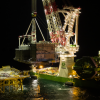We are proud of our dikes, dams, and dunes in the Netherlands, which have long protected us against flooding. This video was made from the ‘point of view’ of Mirte from Rijkswaterstaat. She has a mission and believes we can protect our country by building with nature. Technical solutions alone are not the only solution.
Seagrass fields are not just another part of our ecosystem. They are unique in their ability to battle against the waves and rising sea levels. Their strong roots keep sand in place, a feat that even outperforms forests in CO2 storage. Seagrass also plays a vital role in water purification and oxygen production, benefiting biodiversity. Restoring large seagrass fields is not just a solution; it’s necessary for our environment.
Once upon a time, vast seagrass fields blanketed thousands of hectares of land in the Netherlands. However, from the 1930s onwards, seagrass began to vanish. In collaboration with Natuurmonumenten and Rijkswaterstaat, researchers from the University of Groningen have been injecting seeds and witnessing the successful germination of more plants in recent years, a promising step towards recovering these vital ecosystems. Together with researchers from Radboud University and The Fieldwork Company, they are now working on restoring seagrass in Lake Grevelingen.
Seagrass restoration is undeniably a significant challenge, but we’re gradually conquering it. The progress we’re making, no matter how small, is a testament to the indomitable spirit of nature and the unwavering dedication of those involved. This cause sparks hope and anticipation for a greener, more sustainable future.


